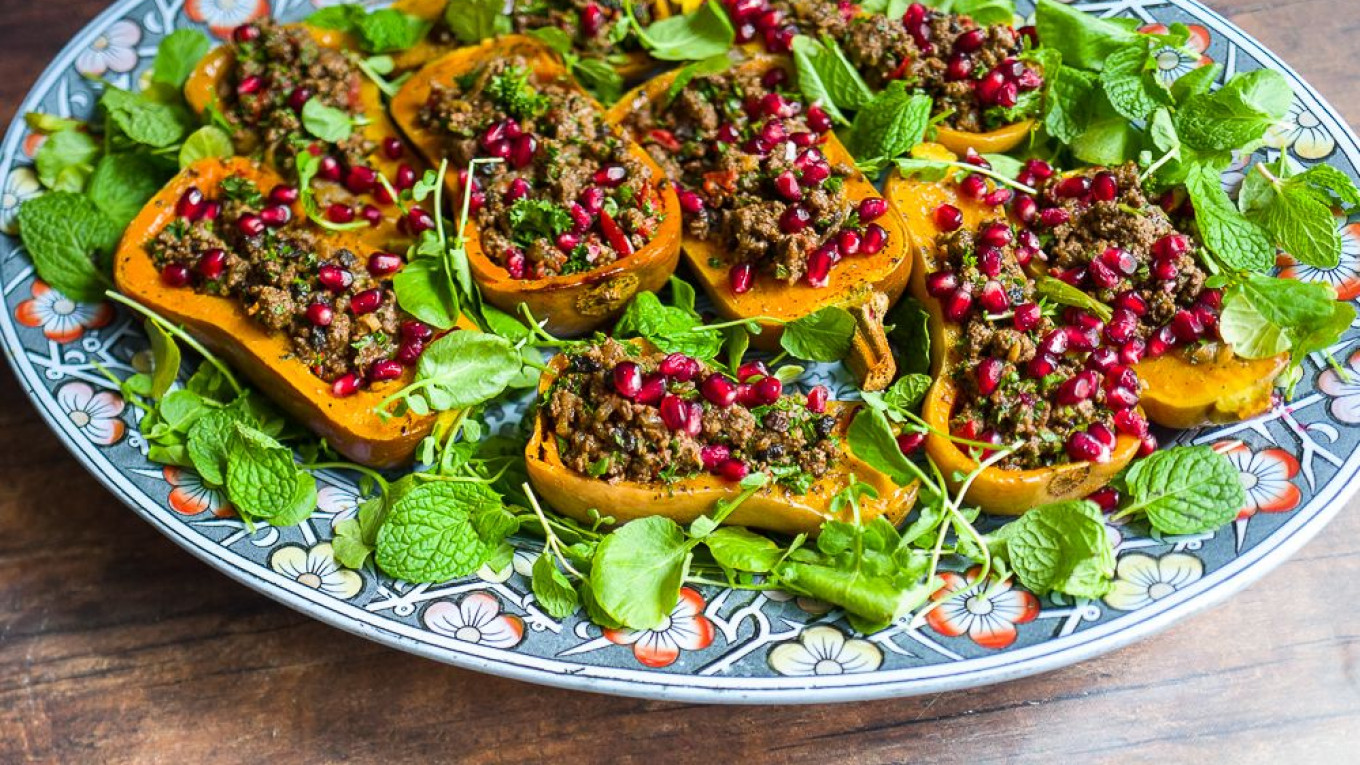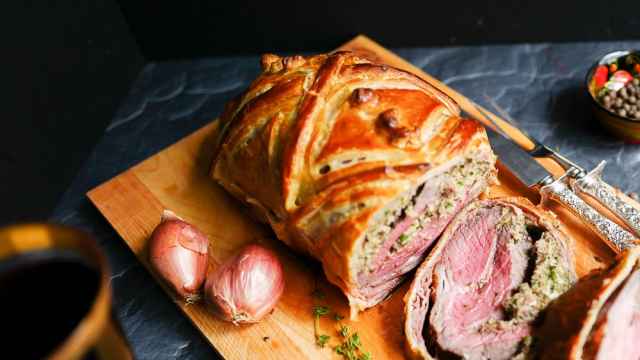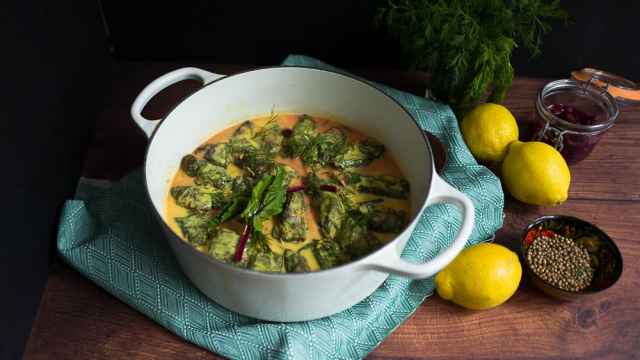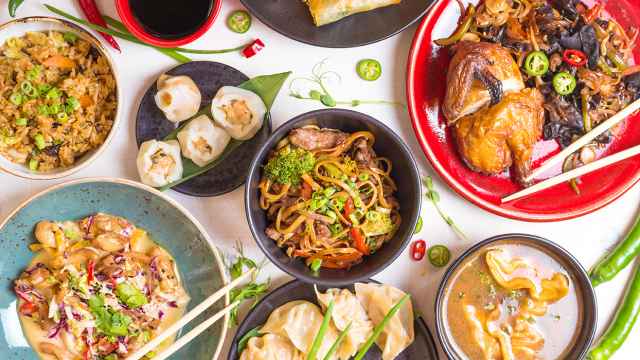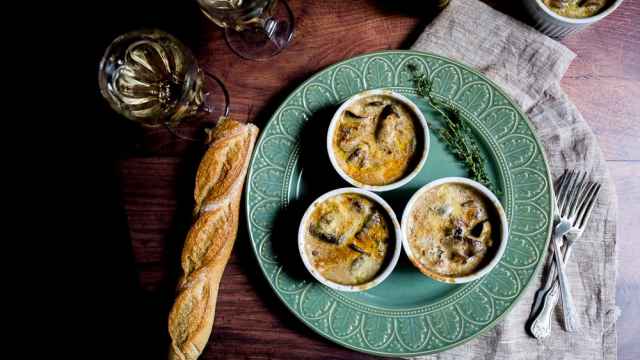Halloween as we think of it — jack-o'-lanterns, children dressed up trick-or-treating, scary decor — is a relatively recent import to Russia. Apart from the expatriate enclaves where they take trick-or-treating very seriously indeed, the holiday has found its most fertile soil in the grown-up playgrounds of nightclubs and bars. And this makes sense, since the (very) scary denizens of these after-hours haunts (really) enjoy dressing up.
I fear that mainstream trick-or-treating may never take off in the world’s largest country. After all, knocks on doors in the evenings in Russia don’t have the same pleasant association they do elsewhere in the world. When my daughter was little, I had an uphill battle trying to convince her Russian father, grandmother, and Nanny that, yes, I was going to let her outside in what they considered a criminal state of undress for several hours to go door-to-door and ask strangers for candy. At the American Embassy, no less. None of them thought much of the idea of putting a lit jack-o'-lantern just outside the door to our apartment, even though the Nanny and grandmother were in total agreement that our neighbor across the landing was a real live witch.

Mokosh: Celebrating the Pagan Female Deity of Fertility
The many-layered tradition of domestic holidays may explain the lack of appetite for Western-style Halloween in Russia. Ancient pagan Russians adhered to the Ynglist calendar, an eight-pointed wheel with each point representing a holiday: the winter and summer solstices and the fall and spring equinoxes are four, as are the “quarter points” between. Between the autumn equinox (Tausen) and the winter solstice (Koliada) on October 28 is the quarter point of Mokosh, the holiday which venerates the goddess of the same name. This is “Damp Mother Earth,” the pagan pantheon’s powerful female deity associated with fertility and the earth itself, but also the fierce champion of women throughout their lives. Mokosh is depicted equally as a young maiden, a sturdy matron, and an old crone, reflecting not only the life cycle of a woman but also the agriculture cycle. Mokosh is often portrayed with her arms raised, holding baskets of grain or flanked by animals.
Mokosh looks after women as they tend crops, weave, spin, and she is always with women in labor. Diligent worship of and timely sacrifices to Mokosh can stave off everything from drought to disease. Married to Perun, the powerful thunder god of the sky, Mokosh spends half of the year with her illicit lover Veles, the god of the underworld and wild nature. Mokosh’s holiday, coming at the end of the harvest meets the goddess at the height of her powers, when she has gifted humanity the abundance of the harvest. But it also marks the moment that Mokosh disappears to spend her time with Veles, in a myth that reminds us of Persephone and Hades. The holiday ushers in the month of Aylet (November) in the Ynglist calendar, a time of full baskets, gifts, and abundance, and to this day in Russia, a very lucky month for weddings and new ventures.
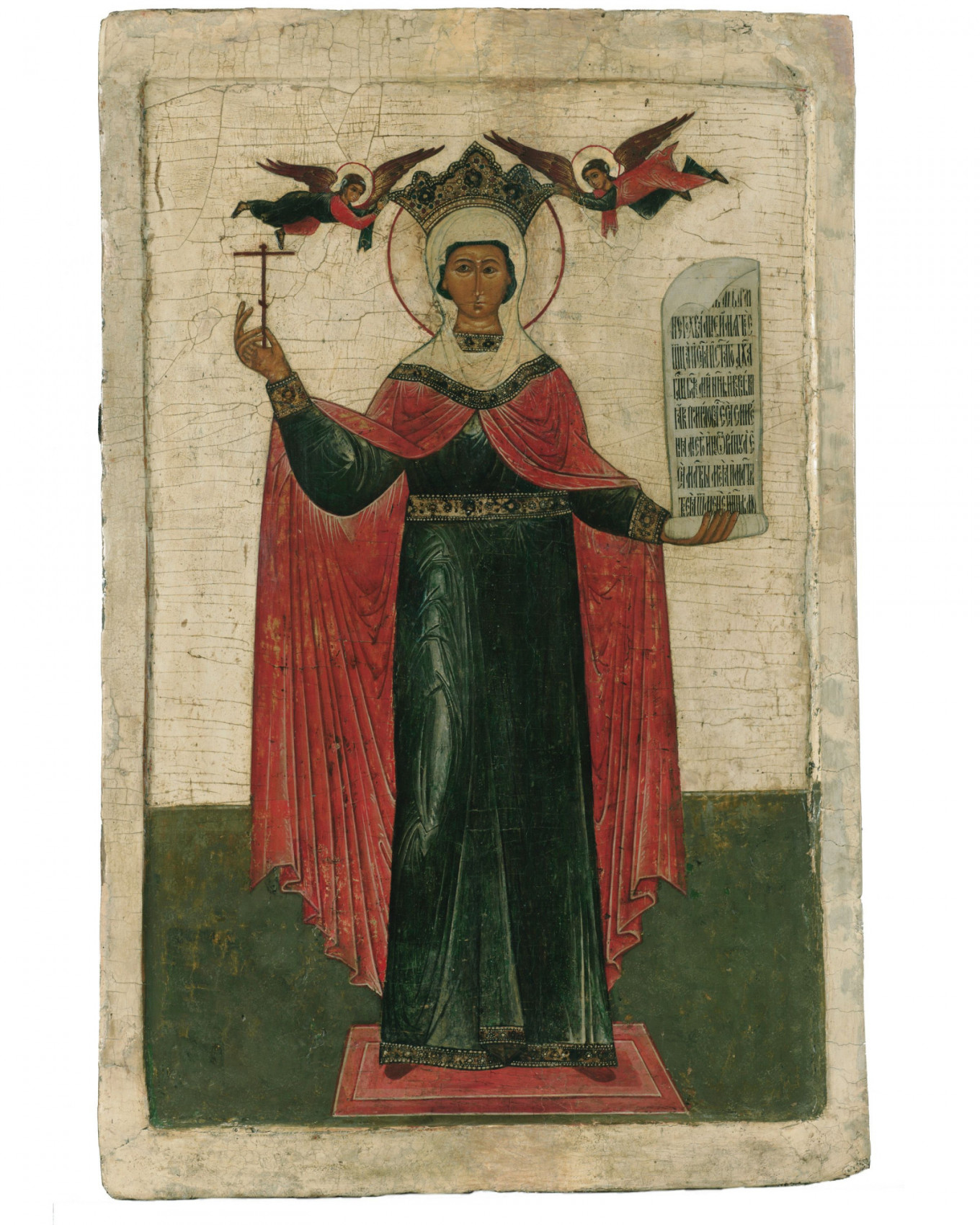
St. Paraskeva-Pyatnitsa: Champion of Women
When Russia adopted Christianity in 988 CE, missionaries from Constantinople found it challenging to stamp out worship of Mokosh, and they cannily gave many of her most venerated attributes to female Christian saints and the Virgin Mary, which is still visible in the larger-than-life portrait of Holy Wisdom, which dominates the main dome of Kyiv’s St. Sophia Cathedral. The figure adopts Mokosh’s traditional raised-armed pose. Mokosh’s image was reproduced throughout the centuries in thousands of red cross stitches as mothers taught their daughters to embroider and to hide their veneration of this powerful female deity in plain sight.
Saint Paraskeva-Pyatnitsa was another female saint whose iconography and traditions mirrored those of Mokosh: she is the patroness of women, particularly those who work with cloth, spinning, sewing, or weaving. October 28 was dedicated to Paraskeva, the protector of women along with Saints Barbara and Catherine, whose saints’ days also fall in late autumn.
For the peasants of Russia, the notion of a “dvoeverie” or “dual-faith” was an easy sell. Many of the new Christian observances were simply grafted on to the eight-sided star points of the Ynglist calendar, creating hardy hybrid holidays, which endured for centuries: Koliada or Yule became Christmas, the summer solstice became St. John’s Night, the spring equinox, Maslenitsa signaled the beginning of the Great Fast before Easter, and Mokosh became St. Paraskeva-Pyatnitsa’s day. The superstitious Russian countryside rocked along very well under their dual faith, and if the pagan traditions sometimes overshadowed the Christian ones, rural priests learned to look the other way.
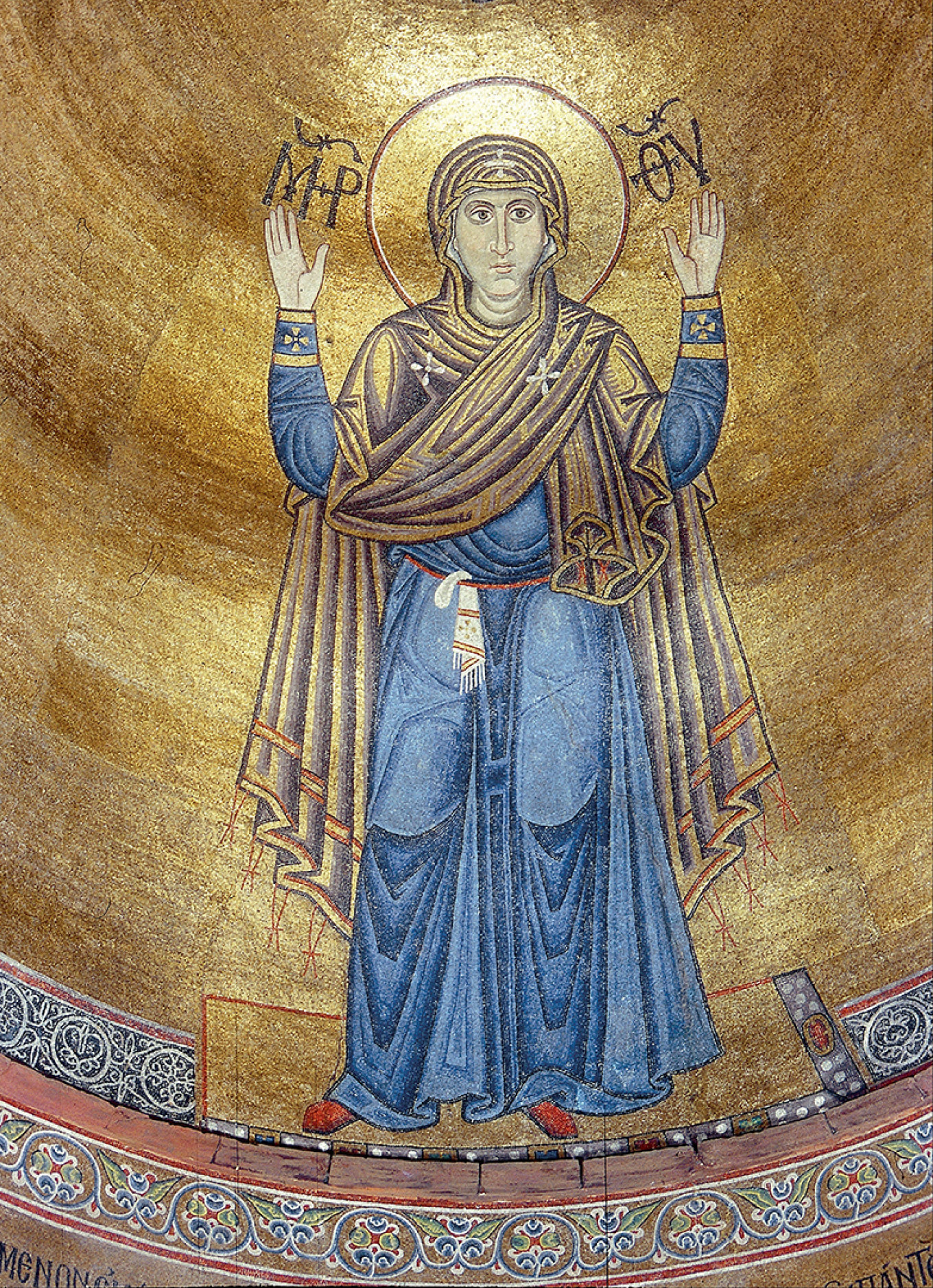
Celebrating Autumn’s End in Soviet Times
When it was the Bolshevik’s turn to upend the cultural applecart, they did not stray far from the approach of the priests, skillfully replacing Christian holidays with secular ones. With Mokosh, the synchronicity was almost eerily accurate, as November 7 commemorated the anniversary of the Great October Socialist Revolution on October 25 (after Lenin updated the outdated Julian calendar to the Gregorian Calendar, thus fast-forwarding Russia by 13 days). This reddest of red dates became the most sacred day in the Soviet calendar, the holiday that dwarfed all others, including May Day and even International Women’s Day. If massive military parades were hardly in keeping with either Mokosh or St. Paraskeva’s traditions, the lavish banqueting and feasting, which accompanied November 7 was a reminder of the season of full baskets.
Many Soviet holidays and traditions have slotted easily into the newly minted post-Soviet culture — May 9 remains a sacred day, as does February 23 (Defenders of the Fatherland Day), and March 8 (International Women’s Day). Even minor holidays such as April 12 (Cosmonauts Day), and August 2 (Paratroopers Day) have proved resilient, and are still celebrated robustly in the new Russia. November 7 has proved clunkier to repurpose, but it is a quarter point on the eight-sided star calendar and thus something must take its place, if only to justify a much-needed long weekend. The Day of Unity and Accord was cobbled together rather hastily to commemorate the victory of Russian troops in 1612 over the Polish-Lithuanian Commonwealth, which ended the tumultuous Time of Troubles. This too fails to capture much of the Mokosh zeitgeist but will have to do until another inevitable cultural upheaval.
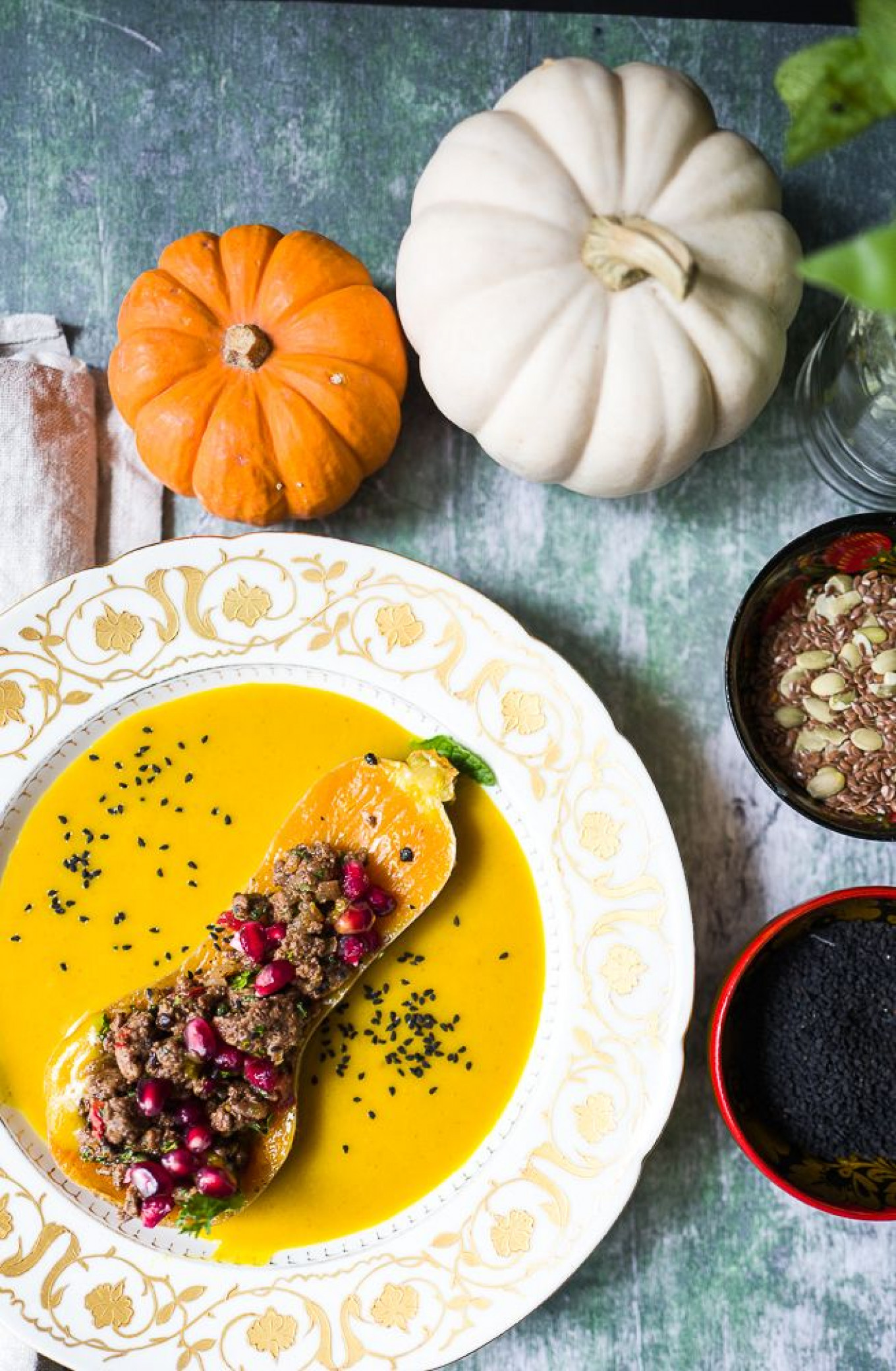
Butternut Squash Soup and Honeynut Boats
Whatever you are celebrating this week: Halloween, the end of daylight savings time, St. Paraskeva-Pyatnitsa, Mokosh, a wedding, the Great October Socialist Revolution, or even a victory over the Poles, you need a suitably rich, autumnal dish that screams “full baskets!” And what could be more autumnal than lovely, vibrant, pungent, bright orange butternut squash?
Here are two recipes, which you can enjoy separately or — for the complete full basket effect — together. Everyone should have a great butternut squash soup recipe in their repertoire, and this one is spicy and boozy, with sweetness from dried apples and maple syrup (or honey) and lots of ginger, and a kick from Calvados. Its already velvety-smooth texture gets even better when you add coconut milk to the mix. This is the perfect antidote to those cold, dark afternoons when you need something with some heft to it to get you to dinnertime.
The Caucasian impulse to stuff vegetables provides the inspiration for honeynut squash boats with lamb. The honeynut squash is a very close cousin to the butternut squash, but it is a bit sweeter and, let’s face it, adorable. These get a quick roast in a hot oven, then are stuffed with a flavorful combination of lamb, barberries, pomegranate syrup, Caucasian spices, and lots and lots of fresh herbs for an innovative main course or hardy side. If you can’t find honeynut squash, use the butternut. But I do love to float the smaller honeynut squash boats into a lake of hot, creamy, steamy butternut squash soup for a presentation that is as delicious as it is attractive.
Whatever you are celebrating this week, I hope your table (or your trick-or-treat bag) is filled with delicious things!
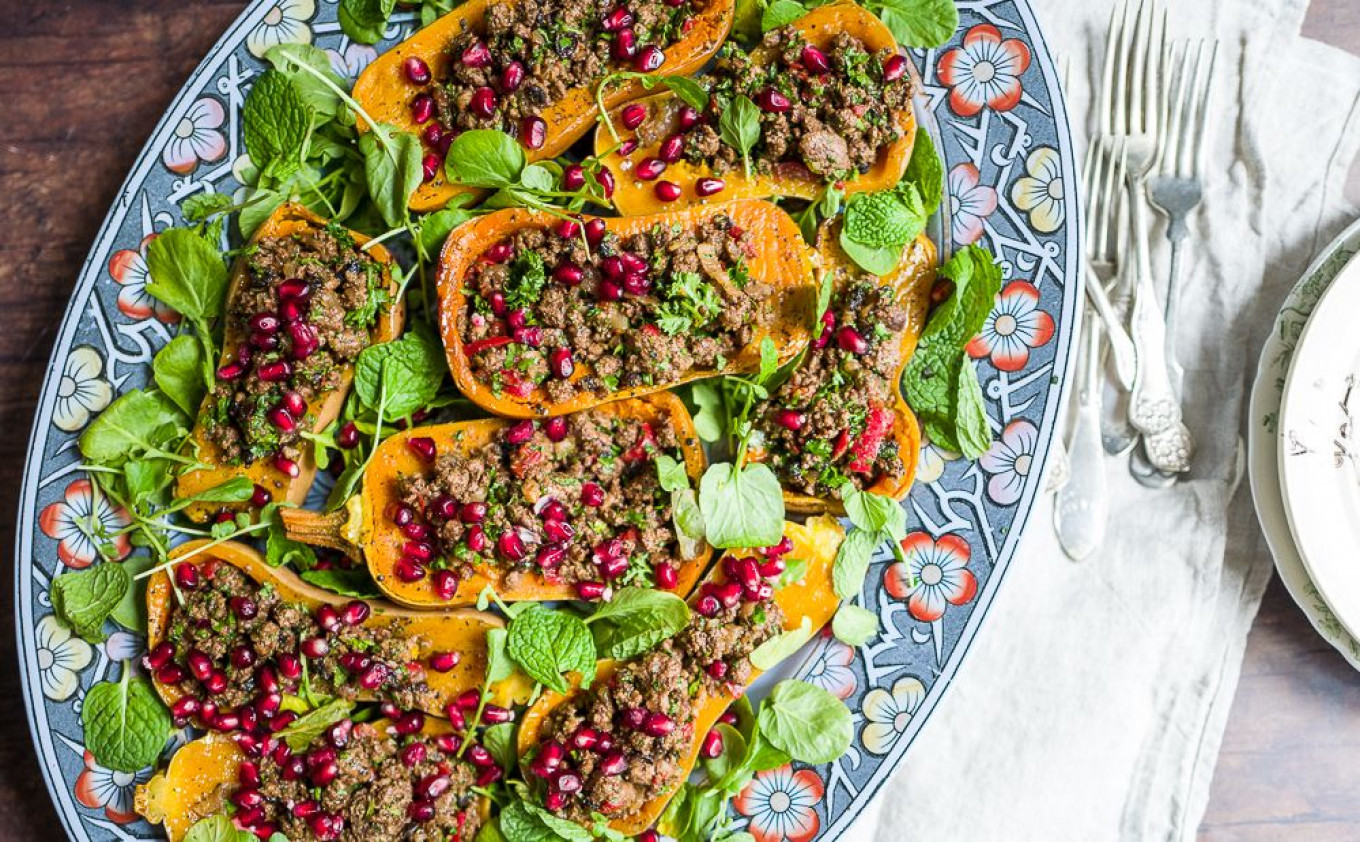
Honeynut Squash Boats with Lamb
Ingredients
- 6 honeynut squash*
- 2 lbs (910 grams) ground lamb
- 2 small to medium-sized onions
- 1 red bell pepper
- Salt and pepper
- Olive oil
- 1 Tbsp sumac
- 2 tsp of Aleppo pepper or dried adjika
- 1 tsp ground cumin
- 2 tsp cinnamon
- 1 tsp coriander seeds
- 2 Tbsp grated ginger
- ½ cup (120 ml) barberries or sour cherries
- ½ cup (120 ml) pomegranate molasses
- 1 ½ cups (350 ml) fresh herbs such as cilantro, mint, tarragon, parsley, or dill plus extra for garnishing
- The seeds of one small pomegranate
Instructions
- Preheat the oven to 400ºF (220ºC) and line a sheet pan with parchment paper. Wash the honey nut squash thoroughly, then slice it lengthwise into two equal halves. Spoon the seeds and slimy pith out of the bottom. Drizzle with the olive oil and season generously with salt and pepper. Roast until the flesh is soft and easily pierced with the tip of a sharp knife (10-15 minutes). Remove from the oven and allow to come to room temperature.
- Heat 1 Tbsp of olive oil over medium-high heat in a heavy-bottomed skillet or dutch oven. When the oil is sizzling, add the ginger and garlic and let them cook for about 2 minutes, taking care that they do not scorch. Reduce the heat to medium and add the onions and pepper and sauté until the pepper is limp. Place the mixture in a bowl and set aside. Wipe out the skillet and return it to the stove over high heat.
- Add the dried spices to the skillet and let them toast for 1 minute until their odor amplifies — take care not to scorch them. Pound them in a mortar with a pestle or grind them in a spice grinder and set aside.
- Brown the lamb in the skillet, using the back of a spoon to break it up. When it turns brown, add the spices and a generous pinch of salt. Cook until the lamb is entirely brown, then lower the heat to medium and add the barberries and onion and pepper mixture. Toss to combine. Add the pomegranate syrup and toss again, making sure that it coats all the meat. Taste and adjust seasoning — if you like it spicier, add more red pepper or dried adjika. Allow the mixture to come to room temperature, then add the fresh herbs.
- Preheat the oven to 350ºF (180ºC). Spoon about 2-3 tsps. from the honeynut squash’s interior, creating a shallow trough; take care to leave enough flesh to allow it to hold its shape. Then pack the hole and the trough with the lamb mixture. Cook the boats for 15 minutes until they are warmed through. Garnish with pomegranate seeds and fresh herbs.
*Recipe Note: If you can’t find honeynut squash, use the smallest butternut squash you can find and increase the roasting time to 20-25 minutes.
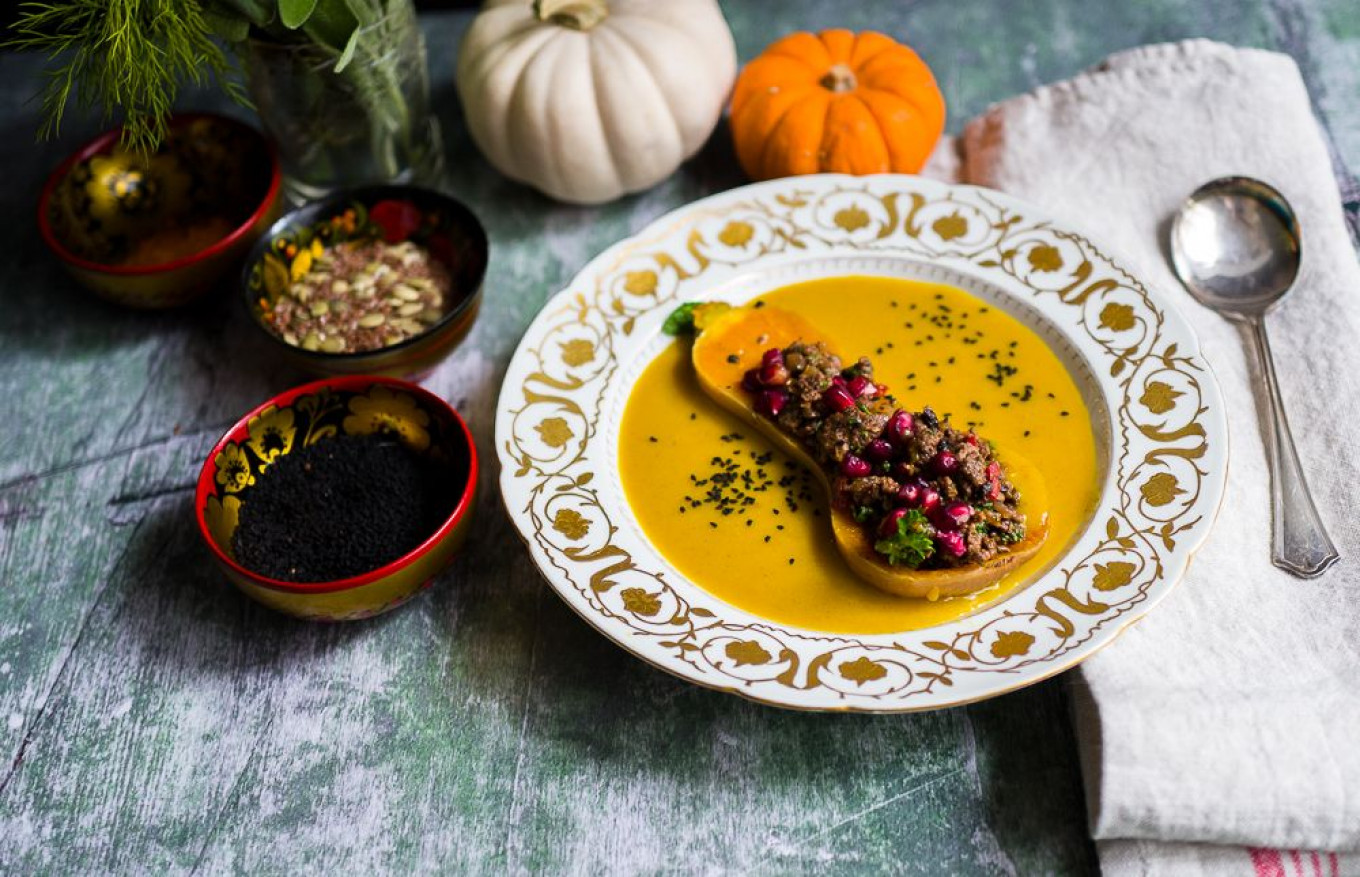
Butternut Squash Soup
Ingredients
- 3 large butternut squash
- 2 large yellow onions, peeled and roughly chopped
- 1 large knob of ginger, peeled and cut into thin coins
- 6 garlic cloves, peeled, smashed and roughly chopped
- ½ lb (200 grams) dried apples
- 2 tsp cinnamon
- 2 tsp coriander seeds
- 1 Tbsp caraway seeds
- 2 tsp sweet paprika
- Salt and pepper
- 2 Tbsp honey or maple syrup
- ⅔ cup (150 ml) Calvados or Canton Ginger Liqueur
- 1 quart (1 liter) cider (if sparkling, leave it to flatten for 45 minutes)
- 2 quarts (2 liters) chicken or vegetable stock
- 2 bunches fresh sage, finely minced
- 2 bay leaves
- 4 sprigs fresh thyme
- 1 14-oz (420 ml) tin coconut milk or 1 cup heavy cream
Instructions
- Preheat the oven to 400ºF (220ºC) and line a baking sheet with parchment paper. Slice the butternut squash in lengthwise and scoop out the seeds and slimy pith from the bottom end. Drizzle with olive oil and season generously with salt and pepper. Roast until the flesh is soft and the tip of a knife slides into it with ease. Depending on the size of your squash, this will be between 20 and 35 minutes. Remove from the oven and cool to room temperature. Then scoop the flesh out of the shell.
- Heat 1 Tbsp of olive oil over medium-high heat in a large soup pot or dutch oven. Add the ginger and garlic and let them sizzle for 1-2 minutes, taking care that it does not scorch. Lower the heat to medium and add the chopped onion and sauté with a generous pinch of salt. When the onions go limp, add the chopped sage and dried spices and cook for 1 minute until they are incorporated into the onion mixture. Then add the Calvados and stir as the alcohol burns off.
- Add the cider and maple syrup and simmer on low heat for 5 minutes. Then add the butternut squash and chicken stock and bring the mixture up to a slow simmer. Add the bay leaves and thyme sprigs. Cover and simmer on low heat for 1 hour.
- Remove the bay leaves and thyme sprigs, then puree the soup in a blender. If you plan to freeze the soup, do so now. If serving immediately, shake the tin of coconut milk vigorously before adding it to the soup base. Serve garnished with nigella or pumpkin seeds, more chopped sage, or a honeynut squash boat with lamb.
A Message from The Moscow Times:
Dear readers,
We are facing unprecedented challenges. Russia's Prosecutor General's Office has designated The Moscow Times as an "undesirable" organization, criminalizing our work and putting our staff at risk of prosecution. This follows our earlier unjust labeling as a "foreign agent."
These actions are direct attempts to silence independent journalism in Russia. The authorities claim our work "discredits the decisions of the Russian leadership." We see things differently: we strive to provide accurate, unbiased reporting on Russia.
We, the journalists of The Moscow Times, refuse to be silenced. But to continue our work, we need your help.
Your support, no matter how small, makes a world of difference. If you can, please support us monthly starting from just $2. It's quick to set up, and every contribution makes a significant impact.
By supporting The Moscow Times, you're defending open, independent journalism in the face of repression. Thank you for standing with us.
Remind me later.



